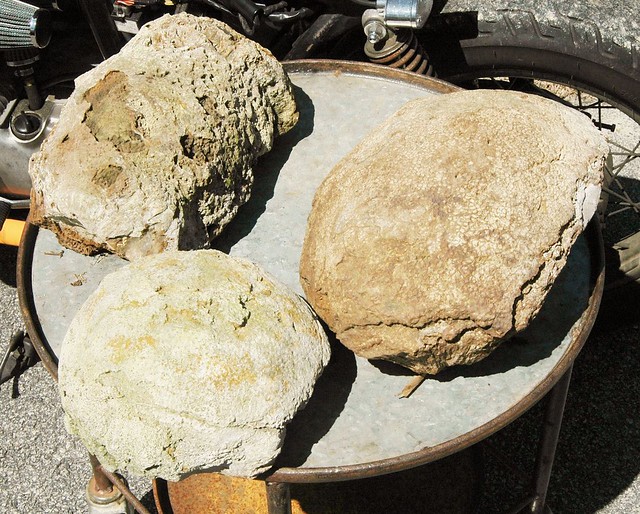Deleted
Deleted Member
Member since January 1970
Posts: 0
|
Post by Deleted on May 8, 2022 21:19:42 GMT -5
|
|
victor1941
fully equipped rock polisher
  
Member since November 2011
Posts: 1,978
|
Post by victor1941 on May 8, 2022 22:00:22 GMT -5
Beautiful coral!
|
|
lparsons
Cave Dweller 
Member since April 2020
Posts: 276 
|
Bee hive?
May 8, 2022 22:02:47 GMT -5
via mobile
Post by lparsons on May 8, 2022 22:02:47 GMT -5
ashley, That’s an amazing specimen. I’ve never seen anything like it. Personally, I would leave it as it.
|
|
|
|
Post by vegasjames on May 8, 2022 22:04:32 GMT -5
Looks like a coral formation. Great specimen.
|
|
|
|
Post by jasoninsd on May 9, 2022 22:52:44 GMT -5
Ashley, if you're still looking for input...I wouldn't get that gorgeous specimen anywhere near a saw. That's definitely a piece that deserves to remain it its present state for as long as it can!  *Great pics of the cellular structures too!  |
|
|
|
Post by fernwood on May 10, 2022 4:53:53 GMT -5
Try searching for honeycomb coral. A type of favosite coral.
Have found a few of these in Central Wisconsin.
I would keep as is. Maybe clean it up a little.
|
|
jamesp
Cave Dweller 
Member since October 2012
Posts: 36,154
|
Post by jamesp on May 10, 2022 7:12:28 GMT -5
In the last photo the rounded 'head' on left with the hex circles or corallites(3rd photo) is the sun facing side or 'up' side. In the upper right of the last photo is where it was rooted into the ground. So it tapers outwardly from the root to the sun facing half globe (top side). The first and 2nd photo is a great side view of the tubes and their inner structures. Search 'fossil scleractinian coral' Here is a similar side view of similar scleractinian coral, root side down, tapering up to sun side on top, and side view of tubes facing you.  Similar but more complete. All sunny side up. Commonly referred to as brain coral. Just make sure it is not a snapping turtle if found in water !  root side to left, sunny side to right. sawed in half. Tubes distorted by silicification  Root side pointing toward center, sunny side facing outward. Heavily silicified and partial pseudomorph silicification at bottom  |
|
Deleted
Deleted Member
Member since January 1970
Posts: 0
|
Post by Deleted on May 10, 2022 9:01:31 GMT -5
Ashley, if you're still looking for input...I wouldn't get that gorgeous specimen anywhere near a saw. That's definitely a piece that deserves to remain it its present state for as long as it can!  *Great pics of the cellular structures too!  Thanks Jason! Always looking for more input!  |
|
Deleted
Deleted Member
Member since January 1970
Posts: 0
|
Bee hive?
May 10, 2022 9:04:44 GMT -5
via mobile
Post by Deleted on May 10, 2022 9:04:44 GMT -5
Try searching for honeycomb coral. A type of favosite coral. Have found a few of these in Central Wisconsin. I would keep as is. Maybe clean it up a little. Thanks! What would you clean it with just soap and water and a scrub brush? |
|
Deleted
Deleted Member
Member since January 1970
Posts: 0
|
Post by Deleted on May 10, 2022 9:05:33 GMT -5
In the last photo the rounded 'head' on left with the hex circles or corallites(3rd photo) is the sun facing side or 'up' side. In the upper right of the last photo is where it was rooted into the ground. So it tapers outwardly from the root to the sun facing half globe (top side). The first and 2nd photo is a great side view of the tubes and their inner structures. Search 'fossil scleractinian coral' Here is a similar side view of similar scleractinian coral, root side down, tapering up to sun side on top, and side view of tubes facing you.  Similar but more complete. All sunny side up. Commonly referred to as brain coral. Just make sure it is not a snapping turtle if found in water !  root side to left, sunny side to right. sawed in half. Tubes distorted by silicification  Root side pointing toward center, sunny side facing outward. Heavily silicified and partial pseudomorph silicification at bottom  Thanks James! Those are really cool looking! |
|